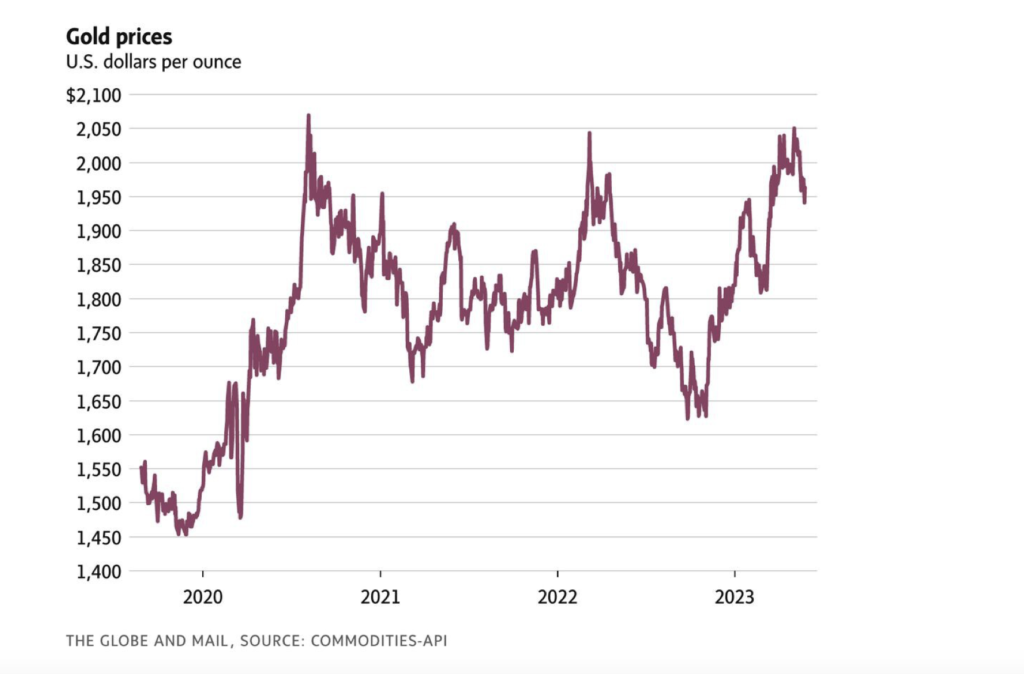Is gold going higher? Here’s what the indicators are saying

The price of gold dropped by more than $100 per ounce over the past month. What caused that drop and where is the price of gold heading from here?
Recent gold price moves:

The price of gold dropped to a low of $1,940 per ounce last week after hitting a year-to-date high of $2,056 early in May. The drop is attributed to a calming of the banking crisis, progress on U.S. debt ceiling talks, strength in the U.S. dollar and an uptick in inflation indicators recently.
All of these factors led to yields on U.S. Treasury bonds climbing by as much as 10 per cent since May 1, and given that gold prices and interest rates have an inverse relationship, gold behaved as we would have expected over the past month.
Even with the recent drop, gold prices have moved up substantially over the past six months, and for the third time since 2020, gold has climbed above, then retreated from, the $2,000 per ounce level.
Let’s look at these relationships in more detail and where gold may be heading:
Debt ceiling talks:
The U.S. government appears to have a deal to raise the debt ceiling prior to the June 1 deadline. (Raising the debt ceiling is the legal authority for the government to increase the amount of total debt outstanding and allow it to issue further debt.) The markets did not expect a default, but foresaw that talks could have continued to the deadline, increasing investor interest in gold as the deadline approached.
Yield curve inversion:
The yield curve on U.S. Treasury bonds is currently inverted, meaning short-term interest rates are higher than long-term interest rates. Since the Second World War, every yield curve inversion has been followed by a recession in the following six to 18 months.
Two- and 10-year treasury yields inverted in July, 2022, (10 months ago) and the spread has widened in the past month (the two-year yield has been rising faster than the 10-year yield). Gold prices tend to increase when there is an inversion in yield curves.
Recession:
According to the U.S. Conference Board, the most recent recession probability estimates remain near 99 per cent, pointing to the likelihood of a recession in the United States within the next 12 months. Even though U.S. GDP growth was above expectations in late 2022 and early 2023, due to better-than-expected consumer spending, the Conference Board continues to forecast GDP growth to decline for three consecutive quarters, starting in the second quarter of 2023.
The price of gold typically rises during a recession as interest rates fall and investors seek out options to hedge against a stock market downturn.
Interest rates and the US dollar:
Rising interest rates are associated with a stronger U.S. dollar and a decline in the price of gold. When real interest rates (the stated or nominal rate less inflation) rise, investors move to higher-return opportunities such as bonds and stocks. When real interest rates fall, gold prices increase, as gold is more attractive relative to other investments.
Real interest rates recently turned positive after being negative for the past two years.
Inflation:
Inflation rates have been falling since they peaked in June, 2022. During times of high inflation, investors move to gold as a safe-haven investment because high inflation generally means negative real interest rates. Higher inflation gives the U.S. Federal Reserve more latitude to raise rates at upcoming meetings.
Summary:
Three of these indicators (debt ceiling, rising interest rates and falling inflation) tell us the price of gold has peaked in the near term. To see gold move higher from here, we would need an environment of falling interest rates caused by a recession. The indictors seem to tell us that is coming later this year or early next year.
Brian Donovan, CBV, is the president of StockCalc, a Canadian fintech based in Miramichi, N.B.
{{ commodity.name }}
{{ post.title }}
{{ post.date }}

Comments